Varanasi, known as the “City of God,” is India’s oldest city, located near the Ganges. It is the most congested city because of the tiny winding streets used by road-side merchants and Hindu temples. Varanasi is well-known for its rich culture and is a major tourist and vacation destination. Varanasi’s main residential area are located far from the Ganges ghats.
Literature
Varanasi has a long tradition of excellent art and literature. Great Indian writers such as Kabir Das, Ravidas, Tulsidas Kulluka Bhatt, Bharatendu Harishchandra, Jaishankar Prasad, Hazari Prasad Dwivedi, Tegh Ali, Kshetresa Chandra Chattopadhyaya, Acharya Shukla, Munshi Premchand, Vagish Shastri, Baldev Upadhyaya, Sudama Pandey, Jagannath Prasad Ratnakar, Devaki Nandan Khatri and Vidya Niwas Mishra have lived in this city.
In Varanasi the art lovers and historians such as Rai Krishnadasa, musician Gopal Mishra, Omkarnath Thakur, Ravi Shankar, Bismillah Khan, Girija Devi, Siddheshwari Devi, Lalmani Misra, N. Rajam, Rajbhan Singh, Anokhelal Mishra, Samta Prasad, Kanthe Maharaj, M. V. Kalvint, Sitara Devi, Gopi Krishna, Kishan Maharaj, Vikash Maharaj, Rajan, Sajan Mishra, Mahadev Mishra, Chhannulal Mishra and numerous others who have kept this city alive to the spiritual aspects of fine arts. People celebrate their various festivals in the traditional forms of Varanasi’s classical and folk culture.
Varanasi also features great museums, including the Jantar Mantar, Archaeological Museum, Bharat Kala Bhavan, and Ramnagar Fort.
Culture of Varanasi
Varanasi is known as the cultural centre of India because of its distinct art culture. It has been the focal point of Indian culture due to its combination of archaeology, customs, natural elements, religious sites, numerous religions, sculpture, and ancient history. Many museums in Varanasi preserve old arts and traditions. It encourages modern people to remember and respect traditional cultures.Many scientific studies have also demonstrated that religious ideas are real and have a good explanation behind them. Religious sites, museums, and monuments tell the true narrative of Varanasi, also known as Kashi.
Varanasi boasts a range of educational institutions, which is why it has become a hub of education for all religions across the world. People refer to it as the capital of education because of its significant contribution to education. Indian classical music, theatre, and other activities are inextricably linked with Varanasi’s outstanding culture. It is the birthplace of famous legends who have made significant contributions to the development of the city. Every year, people in Varanasi perform Ramlila theatre to depict the truth of the Rama era.
Varanasi culture has always been connected with Varanasi customs. The three major faiths, Hinduism, Buddhism, and Jainism, represent the live culture and religious traditions of Varanasi. Varanasi has evolved into the most important religious pilgrimage site for its pilgrims and worshippers. The Muslims ruled destroyed the previous culture and customs, but they were restored by the great monarch, Akbar. He has played a significant role in preserving Varanasi’s culture and legacy. Varanasi is also a source of natural heritages due to the existence of the sacred River Gange. At the main festivals, people in Varanasi have a strong belief in swimming in the Holy Gange water.
Here are some of the best places to visit in Varanasi:
Are you searching for some of the top tourist attractions in Varanasi that will wow visitors with their magical surroundings and magnificent history? Varanasi, the country’s spiritual centre, is home to over two thousand temples and is so considered as one of the holiest and culturally rich towns in the whole world. It also has several magnificent forts where you can see the regal lifestyle of Kings and Queens. If you’re a shopaholic, it includes both street style stores and massive malls where you can buy whatever you desire at fantastic costs.
Kashi Vishwanath Temple
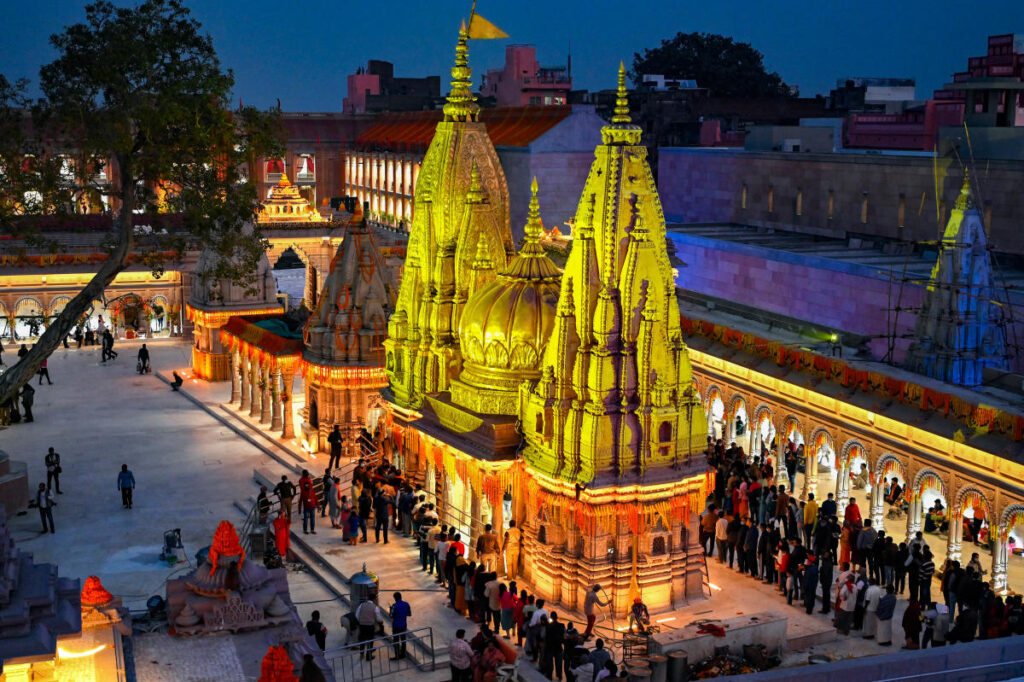
Kashi Vishwanath Temple is a temple in Varanasi, Uttar Pradesh, India. It is one of the most prominent Hindu temples in India.
The Kashi Vishwanath Temple is located on the west bank of the Ganges. It is devoted to Shiva, who has been worshipped here for many centuries in the form of Vishwanatha or Vishweshwara, “Ruler of the World.”
Aarti time:
Mangala Aarti : 3 AM- 4 AM (Morning)
Bhog Aarti : 11.15 AM to 12.20 PM (Day)
Sandhya Aarti : 7 PM to 8.15 PM (Evening)
Shringar Aarti : 9 PM to 10.15 PM (Night)
Shayan Aarti : 10.30 PM – 11 PM (Night)
Temple history
Varanasi, India’s holiest city. Jyotirlinga in the Kashi Vishwanath temple holds outstanding and unique significance in India’s religious history. It draws worshippers from all around the world. On January 28, 1983, the temple was taken over by the UP government. Late Maharani Ahilya Bai Holkar of Indore built the present temple in 1780. In 1785, Collector Mohd. Ibrahim Khan builds a Naubatkhana (in front of the shrine). With 1839, the two domes of the temple were coated in gold (given by Punjab Kesari Maharaja Ranjeet Singh). The Ministry of Culture and Religious Affairs of uttar pradesh goverment gold-plated the third dome.
Holy Ganga River
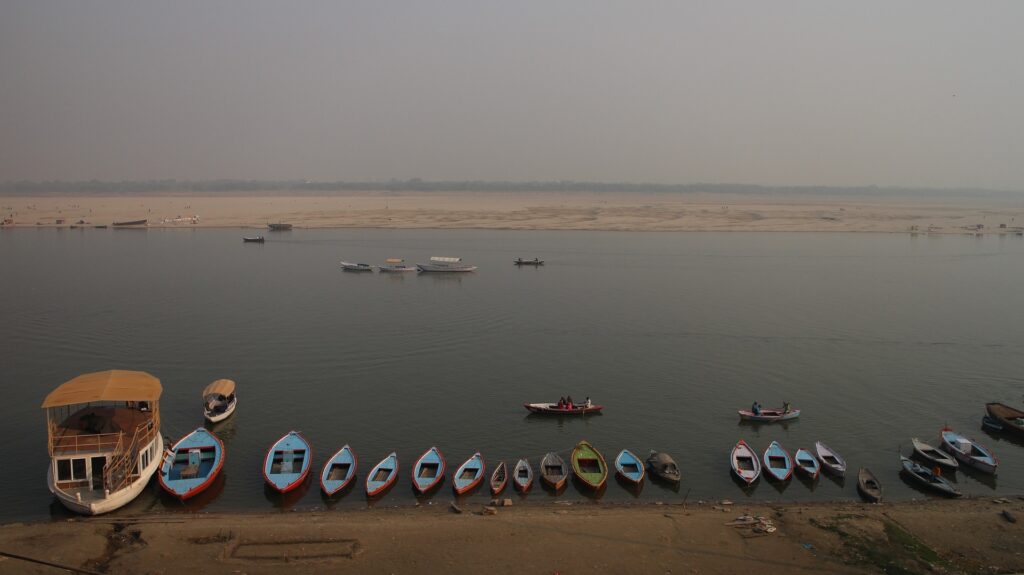
The Ganges River, popularly known as the Ganga, is a river in northern India that flows toward the Bangladesh border. It is India’s longest river, flowing 1,569 miles (2,525 kilometres) from the Himalayan Mountains to the Bay of Bengal. The river has the world’s second highest water output, and its basin is the most highly occupied, with over 400 million people living there.
The Ganges River is incredibly significant to the people of India since the majority of the people who live on its banks rely on it for daily needs such as bathing and fishing. It is extremely significant to Hindus, who regard it as their most sacred river.
life Source:
The Ganges River has become a source of life for over 400 million people who live in its basin in contemporary times. They rely on the river for everyday necessities like as drinking water and food, as well as irrigation and industry. The Ganges River basin is now the world’s most populous river basin. Its population density is around 1,000 persons per square mile (390 per sq km).
Significance of the river:
Aside from providing drinking water and irrigating fields, the Ganges River is extremely important to India’s Hindu population for religious reasons. The Ganges River is considered their most sacred river, and it is worshiped as the goddess Ganga Ma or “Mother Ganges.”
According to the Myth of the Ganges, the goddess Ganga descended from heaven to dwell in the waters of the Ganges River to protect, purify and bring to heaven those who touch it. Devout Hindus visit the river daily to offer flowers and food to Ganga. They also drink the water and bathe in the river to cleanse and purify their sins.
Sacred river:
In most Hindu households, a container of Ganga water is preserved in each home. This is done because it is auspicious to have Holy Ganga water in the house, and if someone is dying, they would be able to drink its water.
Many Hindus believe that Ganga water can cleanse a person’s soul of all past misdeeds and also cure the sick.
According to the ancient scriptures, Ganges water carries Lord Vishnu’s blessings; hence, Mother Ganges is also known as Vishnupadi, which means “Emanating from the Lotus feet of Supreme Lord Sri Vishnu.”
Assi Ghat
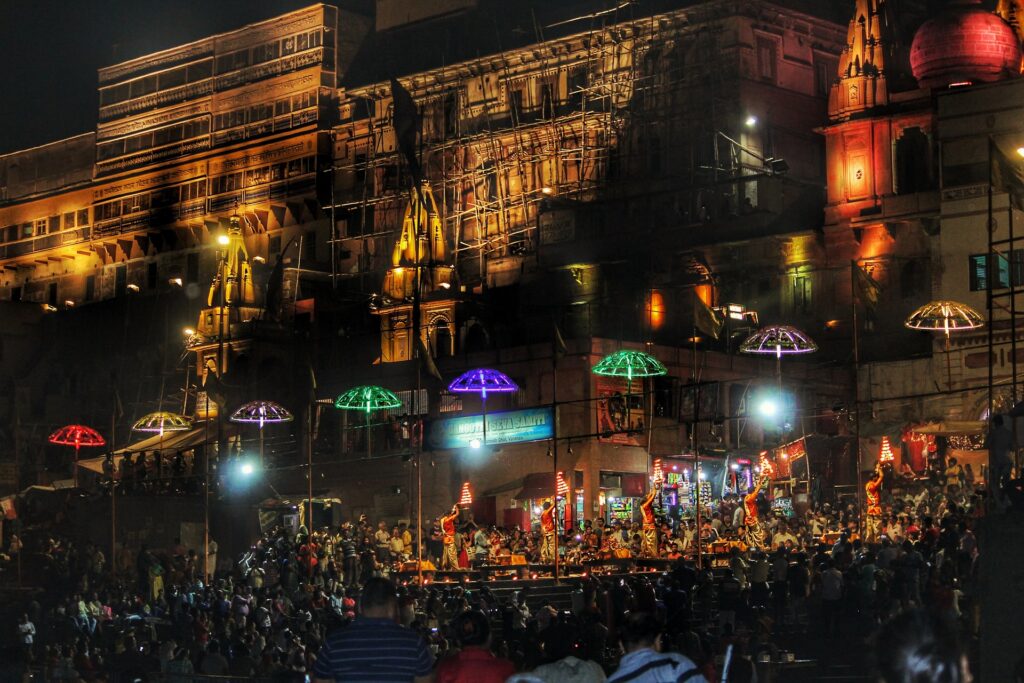
When it comes to popular sites to visit in Varanasi, the city’s southernmost major ghat is consistently at the top of the list. The main feature in Assi Ghat is a Shiva lingam (phallic symbol of the Hindu god) beneath a holy fig tree. Every day, hundreds of pilgrims come to worship Lord Shiva after bathing in the Ganges River.
Feeling a little stiff after your trip? Swing by Assi Ghat at sunrise, when you can perform downward-facing dog with scores of people every day while listening to live music. In the evening, tourists may enjoy another Ganga Aarti performance here, which is somewhat smaller and more personal than the one at Dasaswamedh Ghat.
Ghat attractions:
- Finding boats to hire is easier in this region
- You can find many music and yoga sessions in this ghat, early in the morning
- You can find many entertainers and hawkers in this ghat during evening
- This is the right place for finding luxury hotels to stay.
- Visit the peepul tree near the ghat. People walk around the tree to worship the lingam under the tree.
Manikarnika Ghat
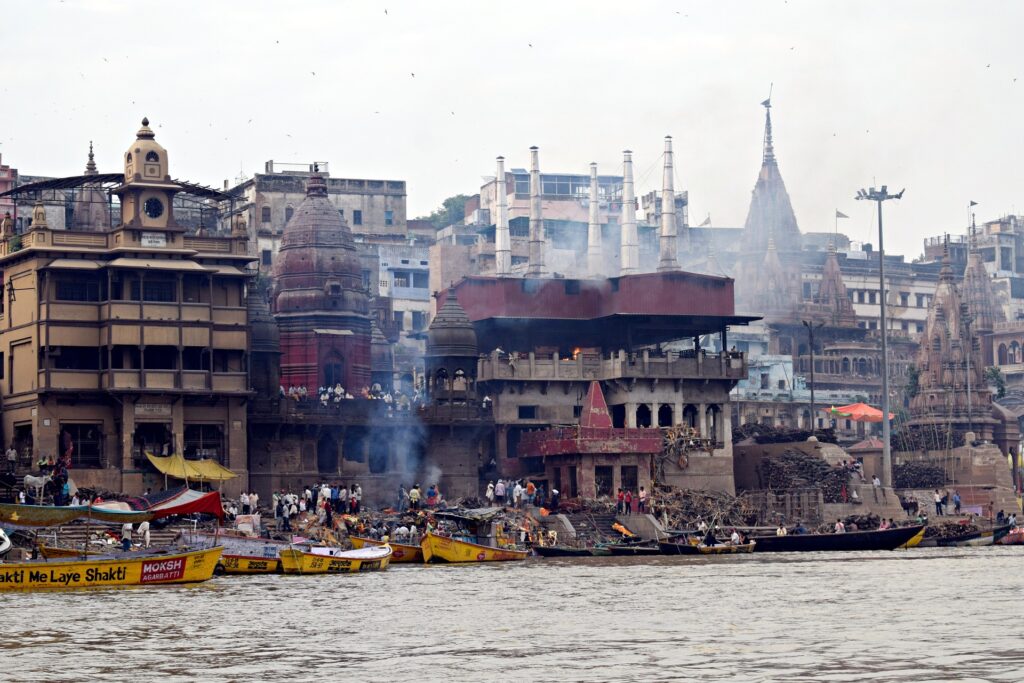
At Manikarnika Ghat, plumes of smoke spiral towards the sky. It’s not from a factory; it’s from the constant cremations that take place on this ghat. Hindus consider Manikarnika Ghat to be one of the most favourable sites for the dead to attain moksha (emancipation from the cycle of spiritual rebirth). The funeral pyre at this ghat burns 24 hours a day, and dozens of cremations are performed every day.
Priests or guides sometimes offer to take tourists on tours of the intriguing ghat, but some can be harsh in their requests for money. You could observe lifters (untouchable caste members) dragging cloth-wrapped bodies on homemade stretchers, as well as stacks of fuel lined up, ready to feed the bonfire.
You may also be given the opportunity to view a cremation up close – for a charge, of course. While profound, the experience is not for the faint of heart, nor is it a standard tourist attraction. Know your boundaries, be respectful, and avoid photographing funerals, mourners, or the deceased.
Ghat attractions:
- You might be a tourist on a well-earned vacation. This does not change the fact that the burning pyre is someone’s dear relative. Do not take pictures or create a touristy effect on the burning ground.
- The best way to scale the place is on a boat from Dashashwamedh Ghat to get a glimpse of the ceremonies in the ghat.
Ramnagar Fort
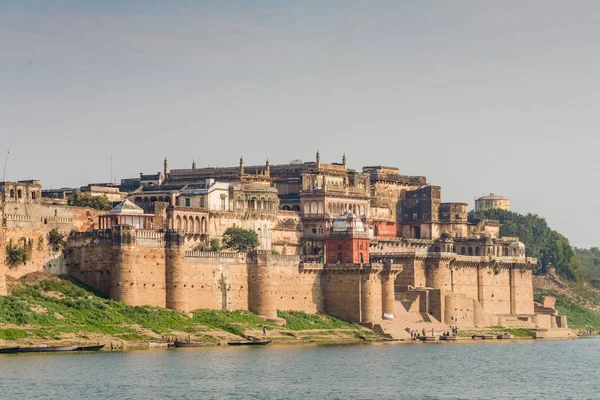
Varanasi is one of the rare Indian locations without a fort. Ramnagar Fort is around 14 kilometres from the city centre. The 18th-century sandstone fort and castle no longer serves as a military fortification, but now contains an unique museum filled with vintage autos, intricate hookahs, ancient weaponry, jewel-encrusted sedan chairs, and a more than 150-year-old astronomical clock
After exploring the museum’s archaeological treasures, visit the fort’s temples, one of which symbolizes Veda Vyasa, author of the Mahabharata and other key Hindu epics.
Fort attractions:
- Best place to watch Ram Lila festival. During the festival, the royal antiques and weapons are displayed to the locals.
- The king visits the fort during this festival on a decorated elephant.
- Explore the fort to spot many palaces, halls, reception rooms, towers and others.
Dashashwamedh Ghat

The Dashashwamedh Ghat’s bustling atmosphere makes it one of the top spots to visit in Varanasi. This tourist attraction is a whirlwind of flower vendors selling brilliant flowers, boat operators selling Ganges River rides, and sadhus (holy men) wearing face paint. During the day, you may spend hours people watching in this neighbourhood.
Every night at approximately 7 p.m., Hindu priests perform the Ganga Aarti at the Dashashwamedh Ghat. The priests, dressed in saffron robes, put out platters of flower petals and other offerings and blow a conch shell to herald the beginning of the spiritual rite. For around 45 minutes, thousands of visitors assemble to see monks chant and waft tiered platters of sandalwood-scented incense in elaborate patterns. It’s a spectacular sight and one of the best things to do in town.
If you want to beat the crowds and get a good place for the spectacle, get at the ghat at least a couple of hours early. Views from boats on the river or store balconies over the ghat are equally spectacular.
Ghat attractions:
- Grand rituals, Ganga arti and other ceremonial activities.
- You can find numerous temples around the ghat
- Boating from the ghat or toward Dashashwamedh ghat is a major activity. Try to enjoy boating during sunrise or sunset. If you are up for some boating experience, it is best to visit Khidkiya Ghat for luxury cruise.
- Pilgrims and locals take a holy dip, early in the morning in this ghat to wash off their earthly sins.
- Special rituals take place near the ghat during every Tuesdays
- Pouring milk into the river from this ghat is considered to be a very holy act.
Panchaganga Ghat
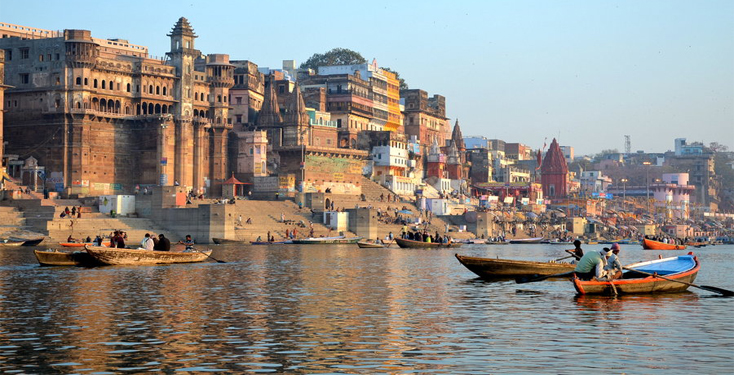
Panchganga Ghat is another prominent ghat along the banks of the Ganga in Varanasi, Uttar Pradesh, located 1.5 kilometres from Manikarnika Ghat and 7 kilometres from Varanasi Junction. It is one of Varanasi’s cleanest ghats and one of the most prominent Varanasi tourist attractions.
Panchganga Ghat gets its name from its location at the confluence of five holy rivers: Ganga, Saraswati, Dhupapapa, Yamuna, and Kirana. Only Ganga is still visible, while the other four are thought to have vanished below the soil. The five river goddesses are represented by five black stone statues. Many worshippers go to this ghat, hoping to get blessings from these five goddesses.
This ghat has a long history. Vaidant Ramanand, the Guru of the renowned saint Kabir, is said to have used Panchganga Ghat as a teaching location. It is also said that the renowned Vinay-Patrika was written here at this ghat by the saint poet Tulsi Das.Your Attractive Heading
Godowlia Market
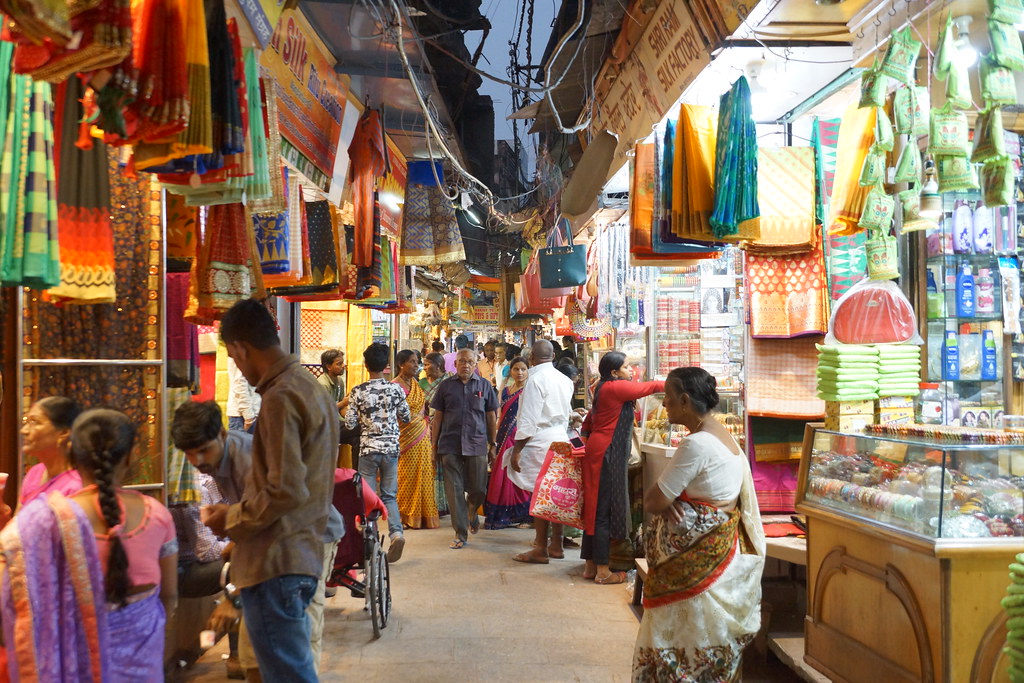
If you leave Varanasi without purchasing, your trip would be incomplete, right? So, pay a visit to the famed Godowlia Market, a favourite shopping destination. The market is around 3 kilometres long and is located in the Kashi Vishwanath Temple region. Scroll through the tiny street dotted with kiosks and businesses selling a variety of things.
Everything from home things to groceries to silk needlework may be found here. The Godowlia Market sells Zari handicrafts, wooden carvings, Bhadohi rugs, and even high-quality things at low prices. Exquisite handicrafts, home décor items, shoes, jewellery, shawls, beads, and bracelets are also available for purchase as keepsakes for family and friends.
Silk Of Banaras

During the Mughal era, Banarasi saris became famous. During this time, all forms of art were combined to produce a fusion of beauty. Mughal patrons preferred Persian themes and Indian designs on silk adorned with gold and silver. Banarasi sarees are being exported all over the world.
Banarasi silk is an unrivalled example of fine workmanship. The Mughals introduced this great artistry to India. Mughals also made an effort to elevate the craft of weaving and design. They encouraged a few craftsmen to work in the difficult technique of weaving during the course of that play. It was the start of the Sari weaving craft. Furthermore, during the period, Persian themes were being combined with Indian traditional dress.
Today’s Banarasi Silks are the result of this special mingling of two different cultures and Mughal zeal. Previously, silk for Banarasi Sarees was imported from China; presently, it is supplied by the southern area of India.
The art and tradition of providing silks for Banarasi sarees is quite old. The tradition of handing down the artistry of Banarasi saris from generation to generation has never been broken. Persian themes were combined with Indian silk designs to create the characteristic floral pattern of Banarasi silk sarees that are so popular today.
Sarnath

Sarnath, located 10 kilometres from Varanasi, is a Buddhist pilgrimage site. This is where Lord Buddha delivered his first sermon after attaining enlightenment. Sarnath is also the birthplace of the 11th Tirthankara. As a result, it is also religiously significant for Jains.
There are regular trains from Varanasi to Sarnath. Train travel from Sarnath to Varanasi takes one hour. The railway station is about one kilometre from the international airport Lal Bahadur Shastri. Cabs and buses may also be found from various sections of the city to Sarnath.
Sarnath attractions:
- Thai temple of Sarnath is famous for the exclusive gardens and architectural style.
- Chukhandi Stupa of 5th century is the place where Lord Buddha had his first meeting with his disciples.
- Mulagandha Kuti Vihar is famous for frescoes, art works and others.
- Tibetan temple is famous for the architecture, Tibetan styled Buddhist paintings, frescoes and others. It holds the Shakyamuni statue.
- Visit the Archaeological and excavation area of Sarnath to spot ruins of monasteries and other ancient buildings.
- Dhammek Stupa is a Maurya Dynasty structure, which is famous among pilgrims
- Ashoka Pillar, the emblem of India is found in Sarnath.
FAQs
1.During which time of the year can I plan a trip to Varanasi?
Varanasi has a subtropical climate; the summers are exceedingly hot, and the monsoons are drenching. Thus, the best time to visit Varanasi is between October and March, during the fall, winter, and spring seasons.
2. What are the top attractions in Varanasi?
It is essential to explore Varanasi’s spectacular ghats and great temples, which include Dashashwamedh Ghat, Manikarnika Ghat, Assi Ghat, and Kashi Vishwanath Temple, among other sights.
3. What should you buy in Varanasi and where should you get it?
Varanasi has several local shopping areas such as Godowlia Market, Vishwanath Lane, and Thatheri Bazaar where you may buy Banarasi sarees, brocade, religious artefacts, handicrafts, and various knickknacks.
4. Are there any nice day-trip destinations around Varanasi?
During your visit to Varanasi, do pay a visit to Sarnath (10 km) that holds immense significance for Buddhist pilgrims and is famous for its many stupas and temples. You can also explore Allahabad, located about 130 km away from the city.




